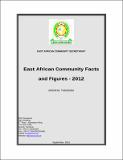| dc.description.abstract | The EAC Facts and Figures Report presents empirical data of socio-economic indicators in the region from which trends of development and growth levels can be analyzed. The data in the report was obtained from the National Statistics Offices, Central Banks of the Partner States and other government departments and targets a wide spectrum of users including policy makers, researchers, investors, academicians and development Partners. The 2012 edition of this report presents data for the year 2011 compared to the previous year. In the social sectors, the report indicates that EAC midyear population was estimated at 135.4 million in June 2011, with average annual growth rate of remaining at the 2.6 percent over the last three consecutive years. The Total Fertility Rate (TFR) in the region was estimated at 5.4 children per woman, down from 5.6 the previous year. Infant mortality rate ranged from 51 to 115 deaths while child mortality rate ranged from 74 to 174 deaths per 1000 infants/children, respectively. In the average, both gross and net enrolment in Primary and Secondary levels of education improved during the year under review. However, the secondary enrolment rates remain substantially lower than that of Primary level.
On economic performance, total aggregate output (at current prices) for the region amounted to US$ 84.7 billion in 2011, compared to US$ 79.9 billion in 2009.Total per capita ranged from US$ 264 in Burundi to US$ 862.4 in Kenya. The dominant sector in all the partner states in 2010 was agriculture, followed by wholesale and retail trade and manufacturing. The transport and communication sub-sector has consistently been improving its contribution to GDP.
On other macroeconomic performance indicators, the annual headline and underlying inflation rates was higher in all Partner States in 2011 compared to the previous year. The rising inflation was attributed to low agricultural production and high fuel prices recorded in 2011. On the external accounts, all Partner States recorded current-account deficits in 2010, which were largely offset by surpluses in the financial account. | en_US |

